Requirements of Computer Networks | Computer Networks - Computer Science Engineering (CSE) PDF Download
Requirements of Computer Networks
Requirements
- Connectivity
- Cost-Effective Resource Sharing
- Support for Common Services
- Performance
Requirements differ according to the perspective:
1. Application programmer
List the services that his or her application needs.
Example: A guarantee that each message it sends will be delivered without error within a certain amount of time.
2. Network designer
List the properties of a cost-effective design.
Example: The network resources efficiently utilized and fairly allocated to different users.
3. Network provider
List the characteristics of a system that is easy to administer and manage. Example: Fault can be easily isolated and it is easy to account for usage.
1 Connectivity
A network must provide connectivity among a set of computers
- Links and Nodes
- Types of Links or Connections
- Direction of Data Flow
- Unicast, Broadcast and Multicast
1.1 Links and Nodes
A network consists of two or more computers directly connected by some physical medium, such as a coaxial cable or an optical fiber. Such a physical medium is called as links.
The links are connected to the computers named as nodes.
1.2 Types of Links or Connections
Point-to-Point
A point-to-point connection provides a dedicated link between two devices. The entire capacity of the link is reserved for transmission between those two devices.
Multipoint
A multipoint (also called multidrop) connection is one in which more than two specific devices share a single link. In a multipoint environment, the capacity of the channel is shared, either spatially or temporally. If several devices can use the link simultaneously, it is a spatially shared connection. If users must take turns, it is a timeshared connection.
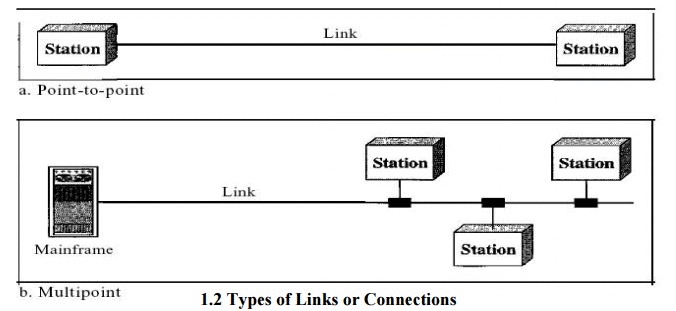
1.3 Direction of Data Flow
Communication between two devices can be simplex, half-duplex, or full-duplex as shown in Figure
Simplex:
In simplex mode, the communication is unidirectional, as on a one-way street. Only one of the two devices on a link can transmit; the other can only receive (Fig a). Keyboards and traditional monitors are examples of simplex devices.
Half-Duplex:
In half-duplex mode, each station can both transmit and receive, but not at the same time. When one device is sending, the other can only receive, and vice versa(Fig b). The half-duplex mode is like a one-lane road with traffic allowed in both directions.
Full-Duplex:
In full-duplex both stations can transmit and receive simultaneously (Fig c)
1.3 Unicast, Broadcast and Multicast
Unicast
Unicast is the term used to describe communication where a piece of information is sent from one point to another point. In this case there is just one sender, and one receiver.
Broadcast
Broadcast is the term used to describe communication where a piece of information is sent from one point to all other points. In this case there is just one sender, but the information is sent to all connected receivers.
Multicast
Multicast is the term used to describe communication where a piece of information is sent from one or more points to a set of other points. In this case there is may be one or more senders, and the information is distributed to a set of receivers (theer may be no receivers, or any other number of receivers).
2 Cost-Effective Resource Sharing
Multiplexing is a way that a system resource is shared among multiple users.

Two or more simultaneous transmissions on a single circuit. Transparent to end user. Multiplexing cost less.
Multiple telephone channels may share a transmission link by means of multiplexing – this sharing is static
–FDM (Frequency Division Multiplexing) is used in analogue systems (a telephone analogue channel has a nominal bandwidth of 4 kHz)
– STDM (Synchronous Time Division Multiplexing) is used in digital systems (the basic telephone digital channel has a capacity of 64 kbit/s)
3 Support for Common Services
A computer network provides more than packet delivery between nodes. We don’t want application developers to rewrite for each application higher layer networking services.
The channel is a pipe connecting two applications. How to fill the gap between the underlying network capability and applications requirements? a set of common services– Delivery guarantees, security, delay.
3.1 Types of Applications
Interactive terminal and computer sessions:– Small packet length, small delay, high reliability.
- File transfer:– High packet length, high delay, high reliability
- Voice application:– Small packet length, small delay, small reliability, high arrival rate
- Video-on-demand:– Variable/high packet length, fixed delay, small reliability
- Video-conferencing– Variable/high packet length, small delay, small reliability
4. Network Creteria
A network must be able to meet a certain number of criteria. The most important of these are performance, reliability, and security.
Performance:
Performance can be measured in many ways, including transit time and response time. Transit time is the amount of time required for a message to travel from one device to another. Response time is the elapsed time between an inquiry and a response. The performance of a network depends on a number of factors, including the number of users, the type of transmission medium, the capabilities of the connected hardware, and the efficiency of the software. Performance is often evaluated by two networking metrics: throughput and delay. We often need more throughputs and less delay. However, these two criteria are often contradictory. If we try to send more data to the network, we may increase throughput but we increase the delay because of traffic congestion in the network.
Reliability:
In addition to accuracy of delivery, network reliability is measured by the frequency of failure, the time it takes a link to recover from a failure, and the network's robustness in a catastrophe.
Security:
Network security issues include protecting data from unauthorized access, protecting data from damage and development, and implementing policies and procedures for recovery from breaches and data losses.
4.1 Categories Of Networking
There are three primary categories are,
1. Local area network.
2. Metropolitan area network.
3. Wide area network.
1. Local Area Network:
They are usually privately owned and link the devices in a single office, building and campus. Currently LAN size is limited to a few kilometers. It may be from two PC‟s to throughout a company.
The most common LAN topologies are bus, ring and star. They have data rates from 4 to 16 Mbps. Today the speed is on increasing and can reach 100 mbps.
2. Metropolitan Area Network:
They are designed to extend over an entire city. It may be a single network or connecting a number of LANs into a large network. So the resources are shared between LANs. Example of MAN is, telephone companies provide a popular MAN service called switched multi megabit data service (SMDS).
3. Wide Area Network:
It provides a long distance transmission of data, voice, image and video information over a large geographical are like country, continent or even the whole world.
4.2 Topologies
Topology refers to the way a network is laid out either physically or logically. Two or more devices connect to a link; two or more links form a topology. It is the geographical representation of the relationship of all the links and linking devices to each other.
1. Mesh
2. Star
3. Tree
4. Bus
5. Ring
1. Mesh Topology:
Here every device has a dedicated point to point link to every other device. A fully connected mesh can have n(n-1)/2 physical channels to link n devices. It must have n-1 IO ports.
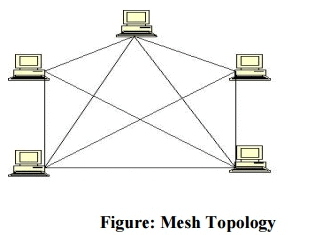
Advantages:
1. They use dedicated links so each link can only carry its own data load. So traffic problem can be avoided.
2. It is robust. If anyone link get damaged it cannot affect others
3. It gives privacy and security
4. Fault identification and fault isolation are easy.
Disadvantages:
1.The amount of cabling and the number IO ports required are very large. Since every device is connected to each other devices through dedicated links.
2.The sheer bulk of wiring is larger then the available space
3.Hardware required to connect each device is highly expensive.
Example:
A mesh network has 8 devices. Calculate total number of cable links and IO ports needed.
Solution
Number of devices = 8 Number of
links = n (n-1)/2
= 8(8-1)/2
= 28
Number of port/device = n-1
= 8-1 = 7
2. STAR TOPOLOGY:
Here each device has a dedicated link to the central „hub‟. There is no direct traffic between devices. The transmission are occurred only through the central controller namely hub.
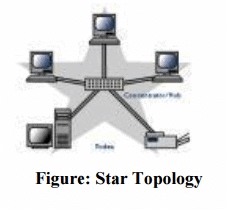
Advantages:
1. Less expensive then mesh since each device is connected only to the hub.
2. Installation and configuration are easy.
3. Less cabling is need then mesh.
4. Robustness.
5. Easy to fault identification & isolation.
Disadvantages:
1. Even it requires less cabling then mesh when compared with other topologies it still large.
Tree Topologies
It is a variation of star. Instead of all devices connected to a central hub here most of the devices are connected to a secondary hub that in turn connected with central hub. The central hub is an active hub. An active hub contains a repeater, which regenerate the received bit pattern before sending.
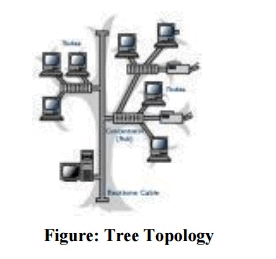
The secondary hub may be active or passive. A passive hub means it just precedes a physical connection only
Advantages:
1. Can connect more than star.
2. The distance can be increased.
3. Can isolate and prioritize communication between different computers.
4. Bus Topology:
A bus topology is multi point. Here one long cable is act as a backbo ne to link all the devices are connected to the ba ckbone by drop lines and taps. A drop line is the connection between the devices and the c able. A tap is the splice into the main cable or puncture the sheathing.
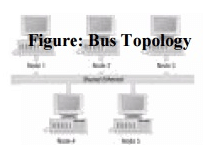
Advantages:
1. Ease of installation.
2. Less cabling.
Disadvantages:
1. Difficult reconfiguration and fault isolation.
2. Difficult to add new devices.
3. Signal reflection at top ca n degradation in quality
4. If any fault in backbone c an stops all transmission.
5. Ring Topology:
Here each device has a dedicated connection with two devices on eith er side of it. The signal is passed in one direction from device to device until it reaches the des tination and each device have repeater.
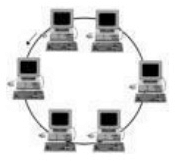
Advantages:
1. Easy to install.
2. Easy to reconfigure.
3. Fault identification is easy.
Disadvantages:
1. Unidirectional traffic.
2. Break in a single ring can break entire network.
Protocols And Standards
Protocols:
In computer networks, communication occurs between entries in different systems. An entity is anything capable of sending or receiving information. But two entities cannot communicate each other as sending or receiving. For communication occurs the entities must agree on a protocol.
A protocol is a set of rules that govern data communication. A protocol defines what is communicated how it is communicated, and when it is communicated. The key elements of a protocol are syntax, semantics and timing.
Syntax:
Syntax refers to the structure or format of the data, means to the order how it is presented.
Semantics:
Semantics refers to the meaning of each section of bits. How is a particular pattern to be interpreted, and when action is to be taken based on the interpretation.
Timing:
Timing refers to two characteristics. They are,
1. When data should be sent
2. When data to be received.
Standards
A standard provides a model for development of a product, which is going to develop. Standards are essential to create and maintain a product.
Data communication products are fall into two categories. They are,
1. De facto
2. De jure
1. De facto:
They are further classified into
1. Proprietary
2. Non proprietary
1. Proprietary:
They are originally invented by a commercial organization as a basis for the operation of its product. They are wholly owned by the company, which invented them. They are closed standards.
2. Nonproprietary:
Groups or committees that have passed them into public domain develop them.
They are open standards.
2. De jure:
They have been legislated by an officially recognized body.
Standards Organisation:
Standards are developed by,
1. Standards creation committee
2. Forums
3. Regularity agencies
1. Standards creation committees:
1. International Standards Organization (ISO)
2. International Telecommunications Union – Telecommunications Standards Section (ITU-T formally CCITT)
3. The American National Standards Institute (ANSI)
4. The Institute of Electrical and Electronics Engineers (IEEE)
5. The Electronic Industries Association (EIA)
6. Telcordia
2. Forums:
1. Frame Relay Forum
2. ATM Forum & ATM consortium
3. Internet Society (ISOC) & Internet Engineering Task Force (IETF)
3. Regularity Agencies:
1. Federal Communication commission
Network Architecture
A computer network must provide general, cost effective, fair and robust among a large number of computers. It must evolve to accommodate changes in both the underlying technologies. To help to deal this network designers have developed general blueprints called network architecture that guide the design and implementation of networks.
|
23 videos|171 docs|81 tests
|
FAQs on Requirements of Computer Networks - Computer Networks - Computer Science Engineering (CSE)
| 1. What are the basic components of a computer network? |  |
| 2. How does a computer network facilitate communication between devices? |  |
| 3. What is the purpose of IP addressing in a computer network? |  |
| 4. What are the different types of computer networks? |  |
| 5. How does a router function in a computer network? |  |

















